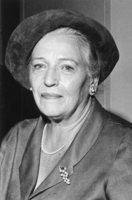 | Back to e-WV
| Back to e-WV
 The West Virginia Encyclopedia
The West Virginia Encyclopedia
 | Back to e-WV
| Back to e-WV
 The West Virginia Encyclopedia
The West Virginia Encyclopedia

Author Pearl Buck (June 26, 1892-March 6, 1973) was the first American woman to receive the Nobel Prize for Literature in 1938. She was born Pearl Comfort Sydenstricker in Hillsboro, Pocahontas County, in the home of her maternal grandparents. This house, now the Pearl S. Buck Birthplace Museum, was for the young girl growing up abroad with her missionary parents ‘‘a symbol of security and peace in a world where there was neither security nor peace.’’ It figures prominently in the early chapters of The Exile, Buck’s fine biography of her mother, which gives a vivid account of life in the Greenbrier Valley in the mid-19th century.
Buck’s parents, Absalom Sydenstricker and Caroline Stulting, were missionaries with the Southern Presbyterian Church. Buck spent much of her childhood in China, where she learned Chinese almost as early as English. She returned to the U.S. in 1910 to attend Randolph-Macon Woman’s College, graduating in 1914. She went back to China as a teacher for the Presbyterian Board of Foreign Missions. In 1917, she married another missionary, John Lossing Buck, an agricultural specialist. Her travels with him to Chinese farming villages provided the settings for many of her best novels.
The next decade brought important changes to her life. Buck gave birth to her only biological child, a daughter, Carol, whose intellectual disabilities were a lifelong source of sorrow. Pearl Buck and Lossing enrolled as graduate students at Cornell University, where she earned a master’s degree in English. She also began submitting writings for publication, in part to earn money to care for Carol and their newly adopted daughter, Janice.
Her literary career was launched with the publication of East Wind: West Wind in 1930. The following year brought worldwide acclaim with the appearance of The Good Earth, winner of the 1932 Pulitzer Prize. From then until her death, Buck wrote prolifically, publishing more than 100 works of fiction and non-fiction. Her major achievement as a writer was in introducing Asia and its people to readers in Europe and North America, but she wrote on American topics as well.
In 1934, Buck moved permanently to the U.S. She divorced Lossing Buck in 1935 and married her publisher, Richard Walsh, who became her partner in many humanitarian efforts. Together they adopted eight children, several of them of mixed-race, and worked tirelessly to improve Asian-American relations. Buck became well-known as an advocate for civil rights and women’s rights, and for people with disabilities. Her most lasting humanitarian legacies are Welcome House, the agency she founded in 1949 to oversee adoption of mixed-race children, and the Pearl S. Buck Foundation, established in 1964 to care for Amerasian children in their home countries.
Buck’s ties with her native state remained strong even in the last decade of her life. In the title essay of My Mother’s House, a small book written by Buck and others to help raise funds for the Birthplace Museum, she paid tribute to the house her mother had cherished while living far away: ‘‘For me it was a living heart in the country I knew was my own but which was strange to me until I returned to the house where I was born. For me that house was a gateway to America.’’ Buck sold nearly 300 manuscripts, including multiple versions of some books, magazine articles, and speeches, to the Pearl Buck Birthplace Foundation in 1970 for $1. The manuscripts are now housed at West Virginia University in Morgantown. The Buck birthplace in Hillsboro was listed on the National Register of Historic Places in 1970. Pearl Buck died of cancer in Danby, Vermont.
In January 2013, a book written by Buck but never published was found in Texas. The Eternal Wonder, believed to have been completed shortly before her death, was published in October 2013.
Read the National Register nomination.
Written by Elizabeth Johnston Lipscomb
Buck, Pearl S. My Mother's House. Richwood: Appalachian Press, 1965.
Conn, Peter. Pearl S. Buck: A Cultural Biography. New York: Cambridge University Press, 1996.
Doyle, Paul A. Pearl S. Buck. Boston: Twayne Pub., 1980.
Hilary Spurling. Pearl Buck in China: Journey to The Good Earth. Simon & Schuster, 2010.